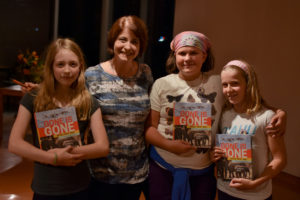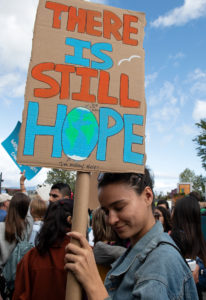 Since my book Gone is Gone: Wildlife Under Threat, with foreword by Jane Goodall, and published by Orca Books was released in September 2019, I have started touring the region, and speaking to young people and their families about acting for the wild.
Since my book Gone is Gone: Wildlife Under Threat, with foreword by Jane Goodall, and published by Orca Books was released in September 2019, I have started touring the region, and speaking to young people and their families about acting for the wild.
I have spoken to many children and youth about the climate crisis and wildlife extinction and many experience a tremendous sense of anxiety, loss and grief.
The call of the youth
As adults, we may be tempted to avoid these discussions in an attempt to protect youth from the harsh realities, but young people are expecting more from us today and are engaging adults in unprecedented ways, leading climate marches and asking us to take action. Will and can we hear them?
I am a mother, and as many others who interact with children and youth, I am worried about the world our young generations will face. When we are bombarded with daily headlines about ecological changes in every corner of the planet, it is easy to lose hope, to feel overwhelmed and powerless. What can we do to make a difference, and does it even matter?

Where do we start?
I believe we have a responsibility to empower and not overwhelm children and youth when considering wildlife extinction, and we can do this from a place of optimism and hope.
I have lived in British Columbia for 20 years, and in that time, I have witnessed local species decline; northern spotted owls, mountain caribou, southern resident orcas come to mind. Extinction does not just happen in far corners of the world. This is the reality of species that live next door, in our province. This means that wildlife conservation also starts on our doorstep.
Any step we can take to protect habitat and wildlife close to home makes a difference for these species and helps create global impact. As Jane Goodall says, “every single individual makes an impact on the planet — every single day.”
There are many steps that children and youth can take with the adults that matter in their lives to help the natural world close to where they live. They can join a citizen science project to help scientists collect information about local birds or amphibians; plant native vegetation to support pollinators; fundraise for a conservation cause; speak publicly for natural spaces and species; enhance biodiversity in an urban park or community garden; and so much more.
Nature, a part of our lives
Most importantly, it comes down to making nature a part of our lives. I live in Vancouver, and every time I am out for a walk, I take notice of the wildlife around me. I encourage my children to pay attention: noticing Anna’s hummingbirds visiting backyard feeders, watching a great blue heron hunt on the seawall or admiring a bald eagle perched on a tall tree near the beach. These sights inspire and enrich our hearts and souls.
Our busy lives do not leave us much time for nature, but we are in this together. There is a growing body of research showing that spending time in nature has tremendous benefits, and it may be time to rethink our children’s busy schedules to make room for nature in the calendar.
The gift of the wild
My book Gone is Gone: Wildlife Under Threat provides many suggestions and resources on how you can act locally for the wild before it is too late.
If you would like to order a signed copy, please contact me. Or you can purchase it online from your favourite bookseller in Canada, the United States, the UK, or any local bookstore. In Victoria, Munro’s carries signed copies and in Vancouver, Kidsbooks also has signed copies.
To arrange a book signing, a speaking engagement, school or library visit, please contact me.
Photos: banner photo and top photo: Yannick Sparta; other photo: Isabelle Groc

